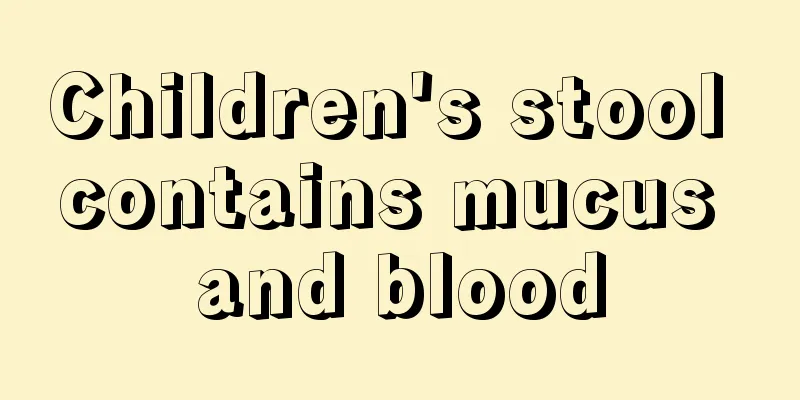Children's stool contains mucus and blood

|
Many parents speculate whether their children have any disease based on their children's stool, and stool is also a substance that can well reflect the disease status inside the human body. Because feces are discharged from the inside of the human body, if there is a problem inside the body, it will be directly reflected in the feces. Many parents have found that their children's stool contains mucus and blood, so what is going on with mucus and blood in children's stool? What to do if your baby has mucus and blood in his stool 1. Caused by digestive tract diseases Digestive tract diseases are the most common cause of bloody stools in babies, including esophageal foreign bodies, ulcer disease, acute gastritis, intussusception, hemorrhagic necrotizing enteritis, intestinal polyps, anal fissures, etc., all of which may cause bloody stools in babies. If there is bright red blood in the stool, it may be caused by rectal polyps, colon polyps and anal fissures, and further examination should be done. If the stool contains a large amount of mucus and less feces in addition to blood, and the child has symptoms of paroxysmal abdominal pain, intussusception should be considered. If the stool contains pus, blood and has a fishy smell, you should consider whether it is dysentery. 2. Infectious diseases Systemic infectious diseases, such as sepsis and typhoid fever, can also cause mucus and blood in the baby's stool. Another common situation is that the newborn swallows the mother's birth canal blood, or sucks breast milk when the mother's nipple is ruptured and bleeding. In these cases, the baby will have bloody stools. 3. Caused by blood diseases Blood diseases can also cause blood in the baby's stool. For example, neonatal hemorrhagic disease, hemophilia, leukemia, aplastic anemia and allergic purpura can cause mucus and blood in the baby's stool. But mothers must not be too anxious, as the baby's bloody stools are not entirely caused by illness. In some cases, in order to resist the invasion of bacteria and viruses, young children's lymphoid tissue proliferates actively throughout the body, and the lymphoid tissue in the rectum, colon and even the lower small intestine gathers into clumps. Some lymphoid follicles are larger, protrude from the intestinal mucosa, and are arranged neatly and closely. The more protruding follicles near the anus are often squeezed by the friction of feces and the contraction of the intestinal wall, and a small amount of bleeding often occurs. The blood gets on the feces and flows to the anus, so mothers see blood in their baby's stool. Mothers don’t need to worry if there is occasional blood in the stool. What to do if your baby's stool is green As long as the baby is healthy and has a normal lifestyle, parents do not need to worry about any changes in the baby's stool. There is nothing serious about changes in color depth; a slightly dry or watery texture does not mean that there is anything wrong with the baby. If the mother is worried, please consult a doctor, community nurse or physician. As your baby grows, eating different foods, such as certain fruits or vegetables, will cause changes in your stool. For example, beetroot can change the color of stool, and stool can turn brown or green when exposed to air. If your baby's stool becomes loose after eating a certain food, you should not give your baby this food for a few days, and then add a small amount of this food to your baby after a period of time. If your breastfed baby has green stools, do not wean him/her easily. At this time, you can shorten the time of each feeding and let the baby eat the first half of the milk. Because the first half of breast milk contains more protein, it is easy to digest and rich in nutrition, while the second half contains more fat and is difficult to digest. If necessary, the mother can drink a large glass of light salt water half an hour to an hour before feeding to dilute the breast milk, and then breastfeed the baby. |
<<: What to do if baby has mulberry inflammation
>>: 3-year-old baby has red blood on his face
Recommend
More and more children are dying from cancer. Do you know why?
There is data showing that in real life, the inci...
At what months can a baby walk? Young parents take note!
A newborn baby needs to go through many stages to...
How to treat choking on water
Summer is coming. In the hot summer, many people ...
What symptoms can pharyngitis cause in children
Herpetic pharyngitis in children most often occur...
What to do if a child has constipation and anal fissure
Don’t underestimate the problem of constipation. ...
What to eat when children have anorexia
Life is gradually improving, and the quality of l...
What to do if your child often breaks his nose
A child's broken nose, or nosebleed, is most ...
How many days should you pay attention to when your baby has a fever?
In daily life, fever and colds are inevitable and...
What might be causing a boy's frequent urination?
Adults have been paying more attention to childre...
The child's shoulders twitched
Many parents find some abnormal conditions in the...
One year old baby's anus is red and painful
Babies are particularly prone to diaper rash when...
Boys anal itching
There will always be some problems during the gro...
What kind of milk is good for children
Milk is a very common food. It is rich in nutrien...
Recipes for children aged 3 to 6
Five years old is a critical period for the baby&...
What should I do if my child likes to get angry?
Everyone has some temper, even children are no ex...









